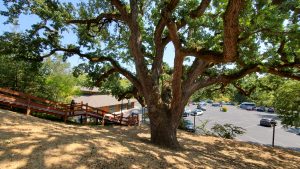 A friend recently approached me and exclaimed, “My driveway is covered in acorns! Way more than in years past. Does this mean we will have a wet winter?” I wish I could have told her that yes an abundance of
A friend recently approached me and exclaimed, “My driveway is covered in acorns! Way more than in years past. Does this mean we will have a wet winter?” I wish I could have told her that yes an abundance of
acorns in October means a lot of rain in January, but unfortunately, that is not why her oaks are dropping lots of acorns. Her trees are experiencing what botanists refer to as a ‘mast’ year.
How oak trees reproduceTo understand what a mast year is, it is helpful to understand how oak trees reproduce. The fruit of an Oak tree is an acorn. A single giant Oak tree can produce nearly ten thousand acorns in a reproductive season. However, Oak trees do not bear fruit every year and some acorns require up to 18 months to mature. When a forest oak produces a high yield or bumper crop, the year is botanically referred to as a ‘mast’ year.
 What is a Mast Year? Mast is a term used to describe the fruit of forest trees and shrubs. The fruit can be hard nuts, like acorns or beechnuts, or soft, like blueberries or wild grapes, and are an important food source for wildlife. A mast year is when a particular woodland species produces more fruit than normal. Like many trees, Oaks have irregular cycles of high and low yields. Oak masting generally happens every 2- 5 years.
What is a Mast Year? Mast is a term used to describe the fruit of forest trees and shrubs. The fruit can be hard nuts, like acorns or beechnuts, or soft, like blueberries or wild grapes, and are an important food source for wildlife. A mast year is when a particular woodland species produces more fruit than normal. Like many trees, Oaks have irregular cycles of high and low yields. Oak masting generally happens every 2- 5 years.
Why do oak trees have mast years? Researchers are uncertain as to the exact reason why oaks and other plants mast. There is a range of theories from climate temperatures and rainfall amounts to harsh summers affecting acorn production or the availability of spring winds during pollination. The specific causes remain a mystery, but one undeniable evolutionary benefit of masting is… ensured future offspring.
Mast years are one of the oaks’ defensive mechanisms  Oaks, like all plants, are firmly rooted in one place and cannot run away from predators. So they have developed mechanisms to protect themselves and ensure that their offspring will reach maturity. In mast years, acorns fall by the thousands increasing food availability for squirrels, mice, birds, and other forest frugivores. The hope is that the animals will become so stuffed with food that some of the acorns will be left on the ground, or forgotten if buried so that they will have a chance to grow into future oak trees. The following year, the trees will bear little to no fruit due to the abundance of energy required to produce the previous year’s bountiful harvest. In subsequent low to no-yield years, wildlife populations decrease as food becomes scarce.
Oaks, like all plants, are firmly rooted in one place and cannot run away from predators. So they have developed mechanisms to protect themselves and ensure that their offspring will reach maturity. In mast years, acorns fall by the thousands increasing food availability for squirrels, mice, birds, and other forest frugivores. The hope is that the animals will become so stuffed with food that some of the acorns will be left on the ground, or forgotten if buried so that they will have a chance to grow into future oak trees. The following year, the trees will bear little to no fruit due to the abundance of energy required to produce the previous year’s bountiful harvest. In subsequent low to no-yield years, wildlife populations decrease as food becomes scarce.
Does a mast year mean we will have a harsh winter? Now there is some old weather folklore about an overproduction of acorns leading to a harsh winter ahead. The problem is the cycle just doesn’t work out all the time and there is little correlation. Some years we have tons of acorns and we have a mild winter, then other years few acorns and a harsh winter. It’s just a 2-5 year cycle that the trees go through to help keep new trees going.
Does a mast year happen to all oaks at the same time? No, it doesn’t. Just because your oak tree is producing thousands of acorns it doesn’t mean your neighbor’s oaks will be too. Each oak tree is on its own cycle.
How long will my oak continue to drop acorns? As a general rule, acorns mature in late summer and start falling from the trees in September or October. In some regions, they may begin as early as August, while in other areas they may continue falling through November or December. By Christmas, they should have dropped the majority of their acorns.
If you have any questions about the health of your oak trees, feel free to contact our office to set up an appointment with one of our certified arborists to inspect your tree.











































